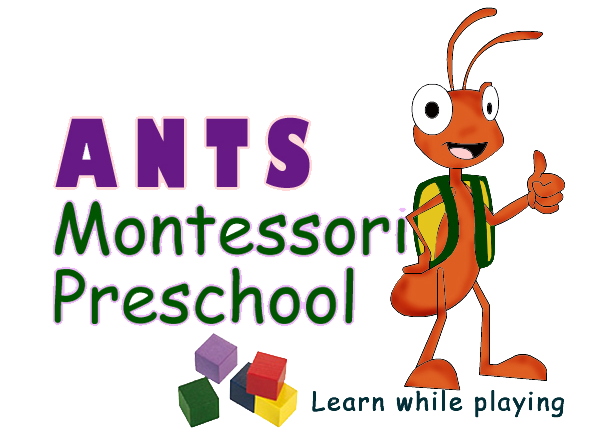
Ants -Montessori Method for pre-school-Bangalore
Montessori School near Ramamurthy Nagar in Bangalore
Dr. Maria Montessori
"The aim of Montessori Education is to foster autonomous, competent, responsible, adaptive citizens who are life long-learners and problem-solvers."

The Montessori Method is an educational philosophy developed by Dr. Maria Montessori in the early 1900′s through extensive trial and error experiments with her own students and patients. Maria Montessori cultivated a home like environment for her students and patients because she discovered they learned best when they felt safe and comfortable. Not only did Maria expect her students to learn academics but also to develop appropriate life skills for them to function in society. By forming these skills, students were also enabled to build their self-esteem as they learned to teach themselves. These advancements in education have a significant impact on Montessori classrooms today.
Specific Montessori goals include the development of positive attitude, self-confidence, concentration, curiosity, initiative, persistence, security and sense of order. Students acquire a high sense of intrinsic motivation, the most effective form of motivation, and push themselves to learn because they want to. Each child’s unique growth rate and learning differences are praised, encouraged, and celebrated in an environment that provides stability and consistency as each student works to their fullest extent.
The Montessori Method is unique in its ability to embrace the whole child and it’s needs, the prepared environment, purposeful materials, and the role of the teacher. Because the student virtually acts as their own teacher and motivator, the official classroom teacher has a significant role as facilitator of learning experiences and role model as they demonstrate the respect and responsibility necessary to function in the real world. They are also expected to be keen observers of each student and their work in the classroom
Maria Montessori traveled an d lived in India during the World War II and she was very impressed by the Mother- child relationships and extended family support in Indian Society. She trained educators and supported the development of Montessori schools in many regions starting in India.
The purpose and aim of Practical Life is to help the child gain control in the coordination of his movement, develop his muscles, hand/eye co-ordination and help the child to gain independence and adapt to his society. It is therefore important to “Teach teaching, not correcting” (Montessori) in order to allow the child to be a fully functional member in his own society. Practical Life Exercises also aid the growth and development of the child’s intellect and concentration and will in turn also help the child develop an orderly way of thinking. The purpose of these exercises is to develop gross motor, fine motor skills, concentration, and to pay attention to detail as the child follows a regular sequence of actions and to learn good working habits. These activities provide the very foundation on which the child approaches more intricate academic exercises.
The purpose and aim of Sensorial work is for the child to acquire clear, conscious, information and to be able to then make classifications in his environment. Montessori believed that sensorial experiences began at birth. Through his senses, the child studies his environment. Through this study, the child then begins to understand his environment. The child, to Montessori, is a “sensorial explorer”. Through work with the sensorial materials, the child is given the keys to classifying the things around him, which leads to the child making his own experiences in his environment. Through the classification, the child is also offered the first steps in organizing his intelligence, which then leads to his adapting to his environment. Each of the Sensorial Materials isolates one defining quality such as color, weight, shape, texture, size, sound or smell
To help the child in his development in language, the classroom is designed to help the child reach the 3rd period of consciousness. Because the learning of language is not done through subjects as in a normal classroom, the child is learning at his own rhythm. This allows the child to concentrate on the learning of each important step in language so that each progressive step is done easily and without any thought on the part of the child. The special material also plays an important role in aiding the child to develop the powers of communication and expression, of organization and classification, and the development of thought. Language is taught through phonetics and materials like the sandpaper letters provide a phonetic basis for reading. With cut -out letters (moveable alphabet), the child builds the words with relation to the pictures by phonetically listening to the sounds in succession and placing the right symbol for each sound. This material frees him from the fatigue of his still developing writing skills, and yet gives him the opportunity to pursue his interest in words.
The materials for Arithmetic introduce the child to associate quantity and its symbols i.e., the numbers 0 through 9. The quantities are introduced by a series of rods, which the child can count. Then he/she matches the sets of symbol cards with the rods. Using a wide range of beads and symbol cards, the child becomes familiar with the numbers as a decimal system, including concrete experiences with the operations of addition, subtraction, multiplication and division. These exercises not only teach the child to calculate, but they provide a deep understanding how numbers function and the relation between the quantity and symbol.
